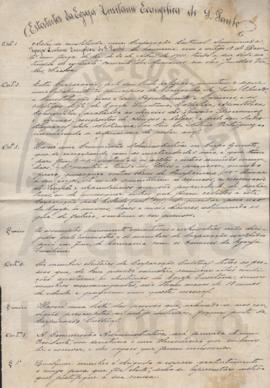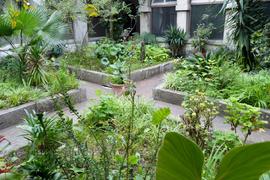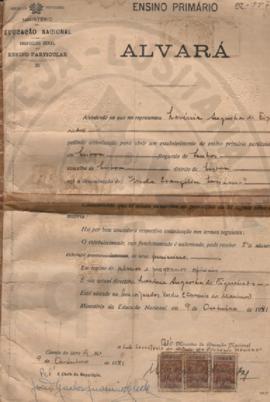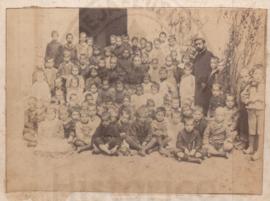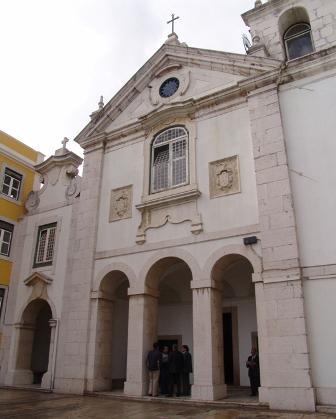
Área de identidad
Código de referencia
PT/ILCAE/PSP
Título
Fecha(s)
- 1876- (Creación)
Nivel de descripción
Fondo
Volumen y soporte
26 liv.; 3 cad.; 1 pt.; 3 mç.
papel
Área de contexto
Nombre del productor
Historia administrativa
A Paróquia de S. Paulo, uma Igreja Lusitana, membro da Comunhão Anglicana, fica situada na Rua das Janelas Verdes (ex-Convento Marianos), entre o Museu de Arte Antiga e a Embaixada Francesa.
O convento dos Carmelitas Descalços da Ordem reformada por Santa Teresa de Jesus (Santa Teresa de Ávila), sob invocação de Nossa Senhora dos Remédios, foi fundado em 1606, tendo a sua construção terminado em 1611. As terras onde foi implantado, estavam aforadas a Vasco Fernandes César e a Francisco Soares pelas Comendadeiras de Santos. Os frades, após consentimento das mesmas, compraram-nas por 820 mil réis.
A esta já vasta cerca que, além de permitir o abastecimento do convento com os géneros agrícolas produzidos, se constituía como um local de lazer para os monges, iria ainda ser acrescentada uma nova porção, doada por Luís César de Menezes, designada por “cerca nova”.
Após expulsão dos frades, o edifício foi requisitado para Quartel do Batalhão 17º da Guarda Nacional em 1835, tendo igualmente sido requisitado para a Pagadoria Militar e Repartição do Comissariado em 1836. O Ministério dos Negócios do Reino concede-o ao Diretor-Geral do Conservatório das Artes e Ofícios em 1837.
Posta à venda em hasta pública em 1872, o imóvel é comprado pela Igreja Presbiteriana Escocesa, facto que provocou acesa polémica.
Em 1898, o conjunto é comprado pela Igreja Lusitana Católica Apostólica Evangélica, onde, atualmente, desenvolve um conjunto de atividades, sendo a mais importante a celebração eucarística dominical.
Segundo Joaquim dos Santos Figueiredo, quando a Igreja Lusitana foi restaurada em 1880, já existia a congregação de S. Paulo, pois havia sido fundada em Janeiro de 1876 e fazia parte da Igreja Episocpal Reformada.
O seu primeiro ministro foi um antigo sacerdote romano, o reverendo António Pereira, que passado pouco tempo se demitiu, indo ocupar o lugar de redator das Atas, na Câmara dos Deputados.
Nesta igreja e no mesmo mês em que os cultos foram inaugurados, professou de um modo solene a sua fé evangélica o Reverendo José Nunes Chaves, que tinha vindo do Algarve para Lisboa e tinha sido membro da Congregação do reverendo Ángel Herreros de Mora, indo depois pastorear a Igreja de Jesus, na Rua de S. Marçal.
As congregações fundadoras desta estrutura nacional, que hoje é a Igreja Lusitana Católica Apostólica Evangélica, foram as igrejas de Rio de Mouro, Sintra, de que era ministro o Reverendo Joaquim José Costa Almeida, S. Paulo, em Lisboa, pastoreada pelo leigo Cândido Joaquim de Sousa, e S. Marçal, também na capital, sendo pároco o Reverendo José Nunes Chaves. Todas elas tinham anexas escolas diárias diurnas, para crianças, e por vezes também ensino noturno para adultos. Em 1880 associaram-se ao movimento as Igrejas de S. Pedro, em Lisboa (antiga Igreja Evangélica Espanhola, fundada por Mora), pastoreada pelo Rev. Henrique Ribeiro Ferreira de Albuquerque, e a do Torne, liderada por Diogo Cassels, então ainda sem ordens sacras.
The St. Pauls Parish, a Parish of the Lusitanian Church – Member of the Anglican Communion – its situated in Rua das Janelas Verdes (ex- Convent of the Marians), between the Museu de Arte Antiga and the French Embassy.
In 1606 it was founded The Convent of the Order of the Discalced Carmelites from the reformulated Order of Saint Teresa of Jesus (known as Teresa of Avila), and dedicated to Our Lady of Remedies. The construction of this Complex was finished in 1611. The land where it was built belonged to Vasco Fernandes César and Francisco Soares and was rented by the Comendadeiras de Santos. The Frails, after being allowed by this Comendadeiras bought this piece of land for 820 mil reis. To the Cincture already existent at that time around the Convent that provided agriculture supplies, and was a place for the rest and recreation of the Frails, another portion of land was eke, offered by a man called Luís César de Menezes, and was known as “The New Fence”.
In 1835 after the Frails were expelled the building was used as a Military Headquarters for the National Guard 17th Company, and in 1836 was required to be the “Pagadoria Militar” (a kind of Military pay-office) and later to be the Office of the Commissariat. In 1837 it was give in by the Ministry of the Realm Affairs to the Headmaster of the Conservatorium of Arts and Crafts.
In 1872, was put up for sale at auction, and amidst a burning public controversy it was bought by the Presbyterian Scottish Church.
In 1898, it was bought by the Lusitanian Church and there at the present moment it develops some activities being the most important the Sunday Eucharistic Service.
According to Joaquim dos Santos Figueiredo, in 1880 when the Lusitanian Church was Ecclesiastically Restored it was already possible to find there the St. Paul’s Local Congregation, because it was founded in January 1876, and was a Parish of the Reformed Episcopal Church.
Its first Local Minister was a former Roman Catholic Priest, the Reverend António Pereira, that gave up his Ministry almost immediately, because he was appointed General Secretary of the Deputies National Chamber.
At this Church and in the same month that the Services began, the Reverend José Nunes Chaves, a Minister that came from Algarve to live in Lisbon, and was a former member of the Reverend Angel Herreros de Mora Congregation, made Solemn Vows to his Evangelical Faith, and was installed as Local Minister at the Parish of Jesus, located at Rua de S. Marçal.
The founding Congregations of the national structure of what we can now call the Lusitanian Catholic Apostolic Evangelical Church are these ones: the church at Rio de Mouro – Sintra, whose Minister was the Reverend Joaquim José Costa de Almeida; St. Paul, in Lisbon, presided by the Lay Candido Joaquim de Sousa and the Parish of Jesus at S. Marçal Street – also in Lisbon, and being its Vicar the Reverend José Nunes Chaves, as mentioned above. Connected to all these Local Parishes there was a Primary School for children and sometimes night teaching for adults.
In 1880 joined this movement of Churches the Igreja de S. Pedro (St. Peter Parish) in Lisbon (former Evangelical Spanish Reformed Church, founded by the Reverend A. H. de Mora), whose Vicar was The Reverend Henrique Ribeiro Ferreira de Albuquerque, and the Torne Church – Vila Nova de Gaia, Porto, led by James Cassels (later he adopted the Portuguese name Diogo Cassels) and at that time yet without Sacred Orders, to these existing parishes.
Institución archivística
Historia archivística
Origen del ingreso o transferencia
Área de contenido y estructura
Alcance y contenido
O fundo da igreja de S. Paulo é constítuido pelas seguintes secções e sub-fundos: SC COR: constituição, organização e regulamentação; SC JP: junta paroquial; SC CUL: culto; SC GF: gestão financeira; SC ED: escola dominical; SC CEL: Coro Evangélico Lusitano; 5 sub-fundos: SF: Ação de Renovação Cristã; SF: Sociedade de Esforço Cristão; SF: Sociedade de Senhoras da Paróquia de S. Paulo; SF: Juventude Auxiliar da Igreja Evangélica de S. Paulo; SF: União Cristã Evangélica; SF: Grupo 53 de Escuteiros; SF: Colégio Evangélico Lusitano.
The archival fonds of the church of S. Paulo is constituted by the following sections and sub-fonds: SC COR: constitution, organization, and regulation; SC JP: parish council; SC CUL: cult; SC GF: financial management; SC ED: Sunday school; SC CEL: Evangelical Lusitanian Choir; 5 sub-funds: SF: Christian Renewal Action; SF: Christian Effort Society; SF: São Paulo Parish Ladies' Society; SF: Auxiliary Youth of the Evangelical Church of S. Paulo; SF: Evangelical Christian Union; SF: Scout Group 53; SF: Colégio Evangélico Lusitano
Valorización, destrucción y programación
Conservação definitiva
Acumulaciones
Sistema de arreglo
Ordenação cronológica
Área de condiciones de acceso y uso
Condiciones de acceso
Mediante autorização da ILCAE
Condiciones
Mediante autorização da ILCAE
Idioma del material
- portugués
Escritura del material
- latín
Notas sobre las lenguas y escrituras
manuscrito
Características físicas y requisitos técnicos
Estado de conservação: razoável
Instrumentos de descripción
Generated finding aid
Área de materiales relacionados
Existencia y localización de originales
Existencia y localización de copias
Unidades de descripción relacionadas
Área de notas
Identificador/es alternativo(os)
Puntos de acceso
Puntos de acceso por materia
Puntos de acceso por lugar
Puntos de acceso por autoridad
Tipo de puntos de acceso
Área de control de la descripción
Identificador de la descripción
PSP
Identificador de la institución
Reglas y/o convenciones usadas
PORTUGAL. DIRECÇÃO GERAL DE ARQUIVOS. PROGRAMA DE NORMALIZAÇÃO DA DESCRIÇÃO EM ARQUIVO: GRUPO DE TRABALHO DE NORMALIZAÇÃO DA DESCRIÇÃO EM ARQUIVO – Orientações para a descrição arquivística. 2.ª v. Lisboa: DGARQ, 2007.
Estado de elaboración
Borrador
Nivel de detalle
Básico
Fechas de creación revisión eliminación
25.05.15 (AV);
26.05.2020 AV
Idioma(s)
- portugués
Escritura(s)
- latín
Fuentes
AFONSO, José António (2007). Protestantismo e educação: história de um projecto pedagógico em Portugal na transição do séc. XIX. Braga: Universidade do Minho. Disponível em: http://hdl.handle.net/1822/7101
NETO, Vítor (1988). A Igreja Lusitana, in 0 Estado, a Igreja e a Sociedade em Portugal (1832-1911), Lisboa: INCM, pp. 527-528. Disponível em: http://ler.letras.up.pt/uploads/ficheiros/2868.pdf
PEIXOTO, Fernando (2001). Diogo Cassels. Uma vida em duas margens. Vila Nova de Gaia: Câmara Municipal de Gaia.
Objeto digital metadatos
Nombre del archivo
Paroquia_S_Paulo_1.jpg
Latitude
Longitude
Tipo de soporte
Imagen
Mime-type
image/jpeg


